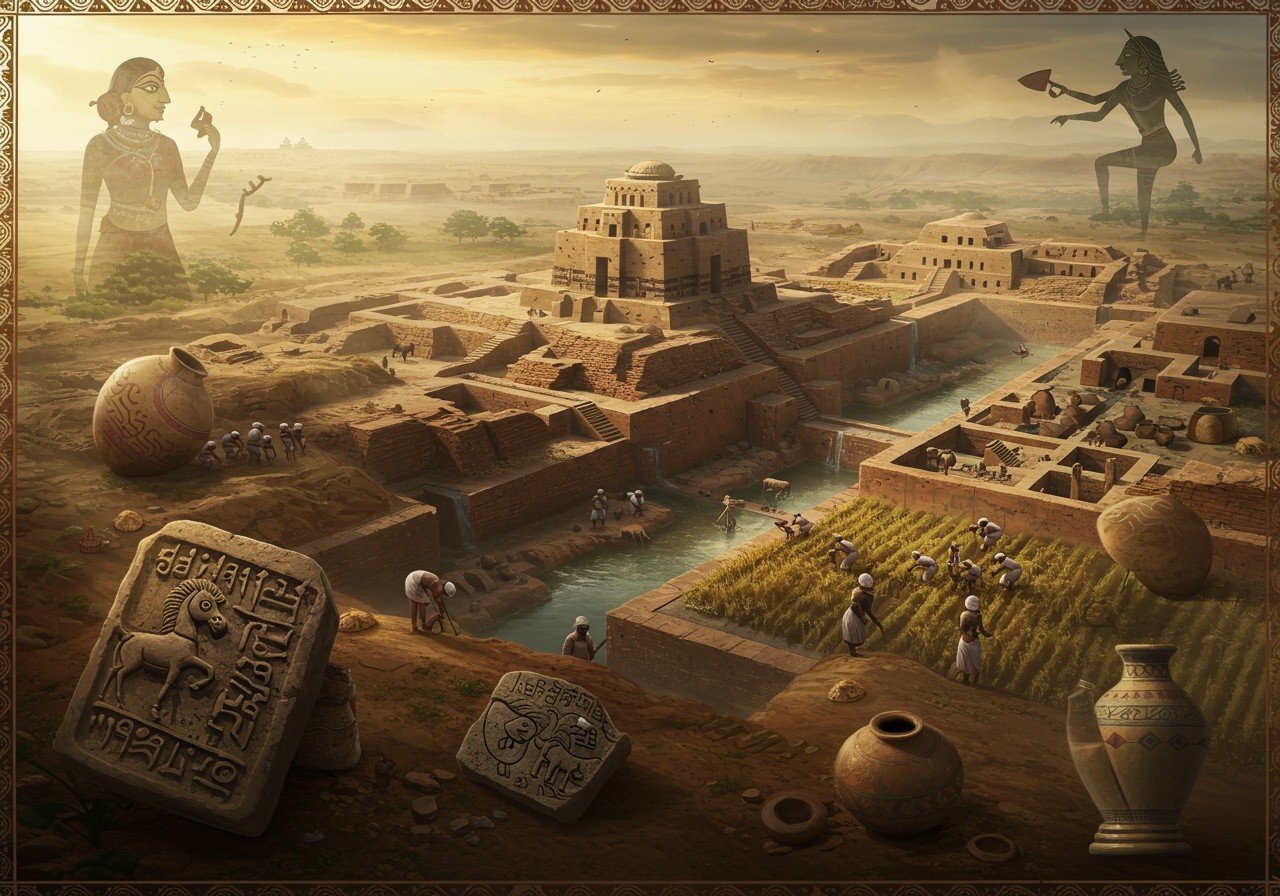
The Indus Valley Civilization, also known as the Indus-Sarasvati or Harappan Civilization, stands as a testament to human ingenuity from the Bronze Age (3300-1300 BCE). Flourishing in present-day Pakistan and northwest India, it’s renowned for advanced urban planning, intricate drainage systems, sophisticated water management, and grid-like neighborhoods complete with roads and alleyways. Evolving from neighboring villages, it adopted Mesopotamian irrigation techniques to thrive in the fertile Indus River valley, skillfully managing annual floods. Major sites and artifacts unearthed reveal its cultural and political significance, as well as its unique script and remarkable architectural achievements.
History of the Indus Valley Civilization
Emerging around 3300 BCE with initial settlements, the civilization reached its zenith between 2600 and 1900 BCE, before gradually declining around 1300 BCE. Key cities like Harappa, Mohenjo-Daro, and Dholavira became bustling centers of activity.
- Geographical Extent: The civilization spanned a vast area across modern-day Pakistan and northwest India, influencing a large region.
- Significance of the Indus River: The Indus River played a crucial role, providing water for agriculture, facilitating trade, and shaping the civilization’s development.
- Socio-Economic Structure: Agriculture formed the backbone of the economy, supplemented by trade and crafts. Cultivation of crops like wheat and barley, along with skilled craftsmanship, contributed to their prosperity.
- Architectural Innovations: The civilization boasted groundbreaking urban planning with grid-patterned cities, sophisticated drainage systems, and impressive granaries, showcasing their advanced engineering skills.
- Art and Culture: A rich artistic tradition is evident in their pottery, intricate seals, and expressive sculptures, reflecting their beliefs and lifestyle.
- Decline Factors: Several factors are believed to have contributed to the civilization’s decline, including environmental changes such as shifts in river courses and potential invasions, though the exact causes are still debated.
Discovery of the Indus Valley Civilization
The rediscovery of this lost civilization in the 1920s, spearheaded by archaeologists like Sir John Hubert Marshall and Rai Bahadur Daya Ram Sahni, marked a pivotal moment in understanding ancient history. Excavations at key sites like Harappa and Mohenjo-Daro gradually unveiled its secrets.
- Initial Challenges: Deciphering the Indus script and interpreting the archaeological findings posed significant challenges initially, hindering a complete understanding of the civilization.
- Role of Archaeological Survey of India: The Archaeological Survey of India played a crucial role in preserving and systematically studying the excavated sites, contributing significantly to our knowledge.
- Impact on Ancient History: The discovery revolutionized our understanding of ancient civilizations, pushing back the timeline of urban development and revealing the sophistication of early societies.
- Ongoing Work: Continued archaeological research and new discoveries continue to provide valuable insights into the Indus Valley Civilization, enriching our understanding of its complexity.
Fascinating Facts About the Indus Valley Civilization
The Indus Valley Civilization possessed many advanced features that were remarkably ahead of their time, showcasing their ingenuity and foresight.
- Urban Planning: The meticulously planned cities, built with baked bricks and organized streets, demonstrate a high level of urban planning and engineering prowess. They even had advanced drainage and sewage systems.
- Efficient Systems: The civilization’s advanced drainage and sewage systems, unparalleled in their time, highlight their focus on sanitation and public health, far surpassing other contemporary civilizations.
- Trade Organization: The use of standardized weights and measures indicates a well-organized trade system, facilitating commerce and economic growth within the civilization and beyond.
- Undeciphered Script: The Indus script, a system of symbols found on seals and artifacts, remains undeciphered to this day, posing a significant challenge to fully understanding their language and communication.
- Trade Evidence: Archaeological evidence suggests extensive trade networks with Mesopotamia and other regions, indicating a vibrant exchange of goods and ideas across vast distances.
- Possible Egalitarian Society: The absence of opulent palaces or monumental temples suggests a possibly more egalitarian social structure compared to other ancient civilizations, although this is still debated by scholars.
- Advanced Metallurgy and Crafts: The civilization’s proficiency in metallurgy and crafts is evident in the variety of artifacts found, showcasing their skills in working with metals and other materials. Explore handcrafted artifacts at Poojn.in.
Poojn.in: Connecting with Ancient Indian Heritage
Poojn.in, India’s leading online store for cultural and religious goods, offers a wide selection of products that resonate with the rich traditions of ancient India. Discover items crafted from pure copper and brass, reminiscent of the metalworking expertise of the Indus Valley Civilization. Explore authentic clay and earthenware products, echoing the pottery traditions of that era. Find traditional puja items and more at Poojn.in.
Conclusion
The Indus Valley Civilization continues to captivate our imagination with its advanced urban development, efficient systems, and thriving trade networks. Ongoing research constantly reveals new insights, reminding us of the ingenuity and resilience of our ancestors. Studying this civilization not only deepens our understanding of the past but also fosters an appreciation for the rich cultural heritage that has shaped our present. Dive deeper into ancient Indian history with our blog.


